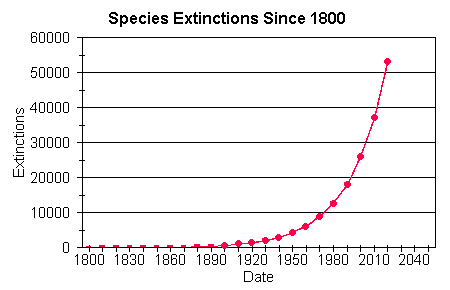
Sustainable Ecology
Shane Partridge Pear Tree Twitter
Holocene - Sixth Extinction Event

Mass Extinction of Earth's Species.
The Holocene Extinction, sometimes called the Sixth Extinction, is a name proposed to describe the currently ongoing Extinction Event of Species during the present Holocene Epoch (since around 10,000 BCE) mainly due to Human Activity. The large number of Extinctions span numerous families of Plants and Animals including Mammals, Birds, Amphibians, Reptiles and Arthropods. Although 875 Extinctions occurring between 1500 and 2009 have been documented by the International Union for Conservation of Nature and Natural Resources, the vast majority are undocumented. According to the Species-Area Theory and based on upper-bound estimating, the present rate of extinction may be up to 140,000 species per year.
The Holocene Extinction includes the disappearence of large mammals known as Megafauna, starting between 9,000 and 13,000 years ago, the end of the Last Ice Age. This may have been due to the extinction of the Mammoths whose habitats had maintained Grasslands which became Birch Forests without them. The new forest and the resulting forest fires may have included Climate Change. Such disappearances might be the result of the Proliferation of Modern Humans. These extinctions, occurring near the Pleistocene - Holocene Boundary, are sometimes referred to as the Quaternary Extinction Event. The Holocene Extinction continues into the 21st century.
There is no general agreement on whether to consider this as part of the Quaternary Extinction Event, or as a distinct event resulting from Human-caused Changes. Only during the most recent parts of the Extinction have Plants also suffered large losses. Overall, the Holocene Extinction can be characterized by the Human Impact on the Environment.
Human Influence on Extinction
Extinction of animals, plants, and other organisms caused by human actions may go as far back as the late Pleistocene, over 12,000 years ago. There is evidence that abrupt Climate Change has especially played an enormous role in the extinction of larger mammals. However, while previous mass extinctions were due to natural environmental causes, research shows that wherever on Earth Humans have migrated, other species have gone extinct, and Human Population Growth, most predominately in the past two centuries, is regarded as one of the underlying causes of this Holocene Extinction Event.


In the terms of how Humans have contributed to this Mass Extinction, three major factors include : The Increased Global Concentration of Greenhouse Gases, affecting the Global Climate; Oceanic Devastation, such as overfishing and Contamination; and the modification and destruction of vast tracts of land and river systems around the World to meet soley Human-Centered ends (with 10 to 15 percent of Earth's land surface now used as urban-industrial or row-crop agricultural sites and 6 to 8 percent used as pastures), thus ruining the local ecosystems.
Other, related human causes of the Extinction event includes deforestation, Hunting, Pollution, and the introduction in various regions of Non-Native Species, and the Widespread Transmission of Infectious Diseases. At present, the rate of extinction of Species is estimated at 100 to 1,000 time higher than the "Base" or historically typical rate of extinction (in Terms of the natural Evolution of the Planet) and also the current rate of Extinction is, therefore, 10 to 100 times higher than any of the previous Mass Extinctions in the history of Earth. It is also the only known mass Extinction of Plants.
Anthropocene Terminology introduced in Year 2000
The abundance of species extinctions considered Anthropogenic, or due to Human Activity, have sometimes when referring to hypothesized Future Events have been collectively called the "Anthropocene Extinction" The Anthropocene is a term introduced in 2000. Most Biologists believe that we are at the beginning of an Anthropogenic Mass Extinction that is accelerating at a large rate.

In the Future of Life (2002), E.O. Wilson of Harvard calculated that, if the current rate of Human disruption of the Biosphere continues, one-half of Earth's higher lifeforms will be Extinct by 2100.
Above all else Humans are the most adaptable Species that have evolved on Planet Earth. Humanity's opportunistic Traits have enabled them to adjust to a multitude of environments on Planet Earth.
But in doing so, the adaptability of Humans have compromised and destablised the Comforts Zones of all Earth's Species including their own. This magnitude of ubiquitous Human Activity on Planet Earth may alter the Trajectory of Earth's Evolution.